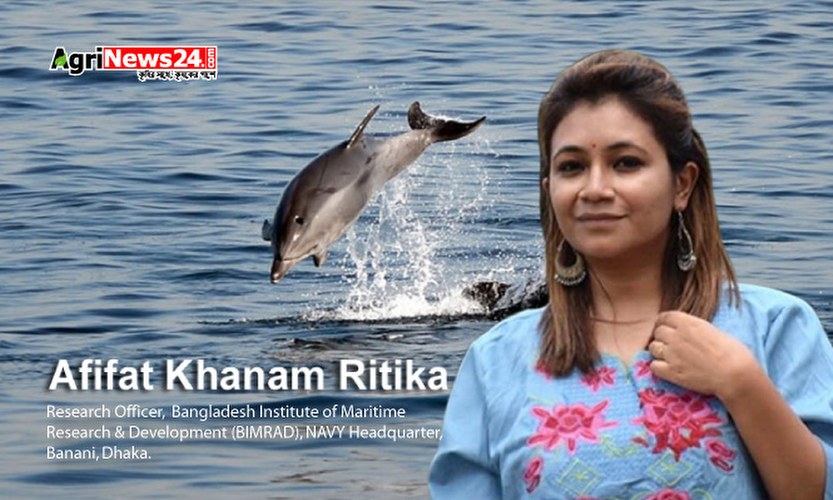 Afifat Khanam Ritika : COVID-19 a new name of threat to the entire world. Bangladesh a densely populated country has also been signified as an affected one. On 7 March, the first coronavirus case was detected after the tests. As a highly contagious virus we all are in a warning as well. To avoid more in Bangladesh, Government has taken so many steps like “shut down” to avoid the contagion. The economy is under murderous threat.
Afifat Khanam Ritika : COVID-19 a new name of threat to the entire world. Bangladesh a densely populated country has also been signified as an affected one. On 7 March, the first coronavirus case was detected after the tests. As a highly contagious virus we all are in a warning as well. To avoid more in Bangladesh, Government has taken so many steps like “shut down” to avoid the contagion. The economy is under murderous threat.
But if we see the opposite side of this viral infection what could we see to the Environment!
As a fisheries expert I am seeing the blessing of this pandemic to the world.
If we give our concern to the BoB what could we see actually??
There is 5,150–8,046 km of navigable waterways, including 2,575–3,058 km of major cargo routes. Bangladesh’s ports and harbors are Chittagong, river ports at Dhaka, Narayanganj, Baghabari and Ashuganj, and seaports at Mongla and Payra. A deep water port has been proposed on Sonadia Island. Around 80 % of Bangladesh trade by volume is transported by ships of different sorts and sizes. There are about 4, 00000 fishing boats operating in the interior and coastal areas of the country. Now a days shipping is one of the grubbiest industries of the world. The next carbon bomb to hit our climate might come from out at sea as emissions from ships generating 3 % of global warming gasses by burning approximately 1 billion metric tons of carbon dioxide and other greenhouse gases every year. Shipping activities generally related to the pollutions coming from the vessel navigation activities including low engine quality, shipping speed, dumping of waste directly into water etc., shipyard production and breaking yard as well.
The Bay of Bengal is a home for world’s largest biodiversity. For sure, not only to protect the climate change but also to protect the huge commercially important marine species, especially to reduce the chances of whale collisions, coral destruction and other mammal breeding, reduction of pollution from shipping activities is now also our regional demand. Environmental damages from shipping activities were mentioned in a report that
- Extinction about 10 different species of seawater fishes
- 21 have become rare in Bangladesh
If we look forward to the tourism, Cox’s Bazar has one of the world’s longest beaches. The uninterrupted 120-km sandy beach is able to host 85,000 visitors daily. According to an unofficial estimation the 155 km unscathed beach engages around 3,000000 tourists everyday round the year on an average in the tourist town Cox’s Bazar. It has been noted that the sandy beach is losing its attraction gradually for the over visitors gathering every day and plastic pollution which is also a part of visitors activity at the sea. During my visit to Cox’s bazar found unbelievable types of wastes including plastic bottles, polythene bags, coconut remains, biscuits and chips packets floating on the seawater at the beach. The corals of St. Martin Island are almost dead, plastic packages, and food wrap discarded by hundreds of tourist daily. Plastics affects the biota directly through the destruction of their feeding ground, side by side, animals consume plastic directly or become entangled. It is really alarming that plastic creates dead zone through banning light penetration from top to bottom and we know without light penetration and water mixing no primary production is possible. Sundarban is a marine biological hotspot. Its amazing ecosystem supports the marine life acting as breeding, feeding and nursery ground, which is also under threat due to indiscriminate extraction and unplanned tourism.
At present almost all types of tourism and shipping have been closed due to avoid the COVID-19 spreading. COVID-19 has been covered almost all littorals. All types of shipping, human pressure or tourism are now closed. According to tourist experts, the March is the pick season for visiting St. Martin’s Island, country’s major beaches and also Sundarban. So, due to COVID-19, all tourism is almost close in those hotspots. During this lock down a new hope has already been rayed after the exposure of indiscriminate dolphins jumping in the Cox’s Bazar near the coast on 26 March, 2020. That has not been seen in last 30 yrs. A report on 28 March published that, in Orissa sea turtles are moving freely all around the desolate beach. This is also a positive indication of nature during the banning of tourism due to COVID-19. Every day 3, 000000 tourist pressures were closed in Bangladesh for 66 days though still it is working in case of tourism.
The present greenish water color indicates the productivity of Cox’s Bazar water. Sagorlata a very popular beach herb has covered the beach during this lockdown. According to a report of daily star published on 10 August 2019, every year about 2 lakh tons of plastics enter into the Bay of Bengal through Bangladesh. Which indicates 547.9 tons per day? If the Govt. ban period we count for 26 March to 30 May 2020, only 66 days has reduced the plastic dumping about 36,161.4 tons, which is about 18.08 % of the total plastic enter into the BoB through BD. So, it gives a clear indication that this 66 days banning has almost reduced 19 % of the plastic pollution in the sea. If we could count the reduction rate of pollution from shipping within this 66 days banning, for sure it would be surprising for the quality development of water and wild life! So, all of those indicates 66 days shut down was able to get back the nature in its healthy fertile condition. Nature is still on our favor. Now time to rethink and take proper action.
The Bay of Bengal is prominent with coastal and marine ecosystems, supporting a wide range of biodiversity, such as fishes, shrimps, mollusks, crabs, mammals, seaweeds, etc. Bay of Bengal and coastal region is one of the most important areas of national economy of Bangladesh. There are about 475 varieties of fishes besides snails, shell-fish, crabs, sharks, octopuses and other animals. Around 511 marine species, together with shrimps, exist within Bangladeshi waters (Murshed-E-Jahan, Belton, & Viswanathan, 2014). Marine fish contributes at least 20 percent of total fish production in the country Bangladesh is estimated to catch only about 0.70 million tons of fish every year out of the total 8 million tons of fish available in the Bay of Bengal (The Daily Star May 14, 2018).
Experts view is that Bay of Bengal is under pressure due to the over excess of human as an exertion to the marine sector without considering its sustainability. Tourism, indiscriminate fishing, destructive gear, cargo operation, direct entrance of disastrous pollutants into the bay from many industries including ship building and breaking sectors etc. are the main reason of sea pollution. During this lock down period due to COVID 19 almost all anthropogenic sources of animal destruction in the marine sectors were closed. This lock down time was a blessing comparing to the life cycle of many marine organisms. Without this pandemic such a 66 days Banning of almost all activities from inland to water was a chimerical story before. This lock down has a great value in addition to its seasonal compatibility on the marine life. In the year 2017-2018, 11111 tons of crab had been exported from Bangladesh and the export earning was 217 crore taka (DoF, 2018). The seeds of this species are available throughout the coastal belt. Though crab seeds are available throughout the year, with a peak season between January and August. If we count our 66 days of lock down amid COVID 19 it was within these peak breeding period of the marine crab. So, it was an eminent opportunity for the crab to breed properly without any human intervention.
The nesting period of sea turtle in Bangladesh begins in the late monsoon to early winter each year with olive ridely first and then the green in late up to rainy season. So, it also indicates a clear notification that these March-April-May were very impeccable for their breeding and nursing. Sea turtle due to lay their egg come to the beach area and then after hatching the baby, babies run out to the sea water. So, huge tourism pressure always affects their breeding, but this COVID 19 has opened a glimmer of hope to get back the marine turtle production more than before.
The another important fact is that, Marine fishing ban period has been started for 65 days, from May 20 to July 23, 2020, to ensure smooth breeding of fish, crustaceans etc . Though it had been determined depending on some analysis on mostly marine species breeding period but little bit back drop is not an unseen scenario for living organisms breeding. So, the forcing ban period for secure breeding of commercially important marine species has been turned into a natural way due to COVID-19. The Seagulls are more frequent even in the coast now a day due to no human interferes in the environment; Seagull indicates the fish and other aquatic animals’ availability as they move around the fish zone for food as fish are their main food. So, their movement all around the sea and coast indicates a rich biodiversity which was unseen before the pandemic.
This shut down was very much crucial time for marine life to replenish the sea. The Government warned of an impending global financial crisis due to the disruption of economic activity caused by the COVID-19 pandemic. Prime minister Sheikh Hasina mentioned that overcome that crisis, we have to pay attention to our agriculture sector and marine sector as well. In this pandemic on June 1, a five-day long Ocean Dialogues was organized by World Economic Forum and Friends of Ocean Action. Prime Minister Sheikh Hasina participated and mentioned that this pandemic makes them all to rethink the linkage between the health of the ocean and the health of the mankind as ocean offers a great source to combat illness. At this pandemic to regain/recover the economic condition, sea is the alternative way. A healthy ocean is a vast source of food and nutrition, ocean can provide six times more food than it does today and help meet the nutrition supply.
The environmental scenario during this Pandemic teaches us to rethink. It is very important for the responsible ministry and department to count the production rate of commercially important species this year and to compare with the past to find out the way for better management of the sea. Policy makers need combined measurement, action plan and implementation of law to protect the marine resources and control marine pollution.
COVID-19 is a word to look forward. To me, COVID-19 is a word of realization.
Author: Research Officer, Bangladesh Institute of Maritime Research & Development (BIMRAD), NAVY Headquarter, Banani, Dhaka.
 Agrinews24 কৃষির সাথে, কৃষকের পাশে
Agrinews24 কৃষির সাথে, কৃষকের পাশে





















